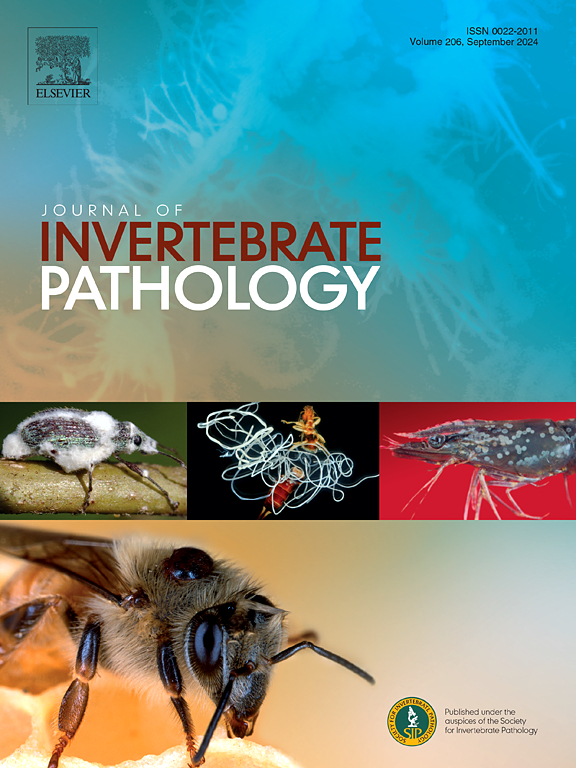Transcriptome analyses reveal Beauveria bassiana endophyte induced disruption of aphid physiology
IF 2.4
3区 生物学
Q1 ZOOLOGY
引用次数: 0
Abstract
Some strains of entomopathogenic fungi are known to colonize crops endophytically, providing systemic protection against insect pests. This colonization has been revealed to reduce aphid survival and reproductive potential. Understanding the molecular mechanisms underlying these effects could provide insight into what occurs to aphids when they feed on endophytically colonized plants. In this study, an RNA sequencing (RNA-Seq) was conducted for transcriptome analyses of the melon aphid Aphis gossypii and its symbiotic bacteria after feeding on Beauveria bassiana endophytically colonized melon plants. The fungal colonization triggers significant alterations in the aphid transcriptome, reflecting molecular responses to fungal propagules and/or plant-induced systemic resistance. Key changes include the up-regulation of genes involved in host plant recognition by the aphid pest, immune system activation, energy production, and defense mechanisms such as toxin adaptation, detoxification, and cell death markers. Genes associated with escape responses, including alarm pheromone production and wing bud differentiation, were also up-regulated. In contrast, down-regulated genes point to disruptions in homeostasis and neuronal function, further impacting aphid physiology and its symbiotic relationship with Buchnera. These molecular perturbations likely underlie the lethal and sublethal effects observed in aphids feeding on B. bassiana-colonized plants. This study identifies critical pathways involved in aphid-fungal-plant interactions, offering valuable insights into the potential of endophytic entomopathogenic fungi for aphid pest management.

转录组分析显示球孢白僵菌内生菌诱导蚜虫生理破坏
已知一些昆虫病原真菌菌株在作物内生定植,提供系统保护以抵御害虫。这种定殖已被发现会降低蚜虫的存活率和繁殖潜力。了解这些作用背后的分子机制可以让我们深入了解蚜虫以内生定殖植物为食时会发生什么。本研究利用RNA测序技术(RNA- seq)对内生定殖球孢白僵菌(Beauveria bassiana)侵染甜瓜植株后的棉蚜及其共生菌进行转录组分析。真菌定植引发蚜虫转录组的显著改变,反映了对真菌繁殖体和/或植物诱导的系统性抗性的分子反应。主要变化包括蚜虫对寄主植物识别、免疫系统激活、能量产生和防御机制(如毒素适应、解毒和细胞死亡标记)相关基因的上调。与逃逸反应相关的基因,包括报警信息素的产生和羽芽分化,也被上调。相反,下调的基因指向体内平衡和神经元功能的破坏,进一步影响蚜虫的生理及其与Buchnera的共生关系。这些分子扰动可能是在蚜虫取食球孢白僵菌定殖植物时观察到的致死和亚致死效应的基础。本研究确定了蚜虫-真菌-植物相互作用的关键途径,为内生昆虫病原真菌在蚜虫病虫害管理中的潜力提供了有价值的见解。
本文章由计算机程序翻译,如有差异,请以英文原文为准。
求助全文
约1分钟内获得全文
求助全文
来源期刊
CiteScore
6.10
自引率
5.90%
发文量
94
审稿时长
1 months
期刊介绍:
The Journal of Invertebrate Pathology presents original research articles and notes on the induction and pathogenesis of diseases of invertebrates, including the suppression of diseases in beneficial species, and the use of diseases in controlling undesirable species. In addition, the journal publishes the results of physiological, morphological, genetic, immunological and ecological studies as related to the etiologic agents of diseases of invertebrates.
The Journal of Invertebrate Pathology is the adopted journal of the Society for Invertebrate Pathology, and is available to SIP members at a special reduced price.

 求助内容:
求助内容: 应助结果提醒方式:
应助结果提醒方式:


